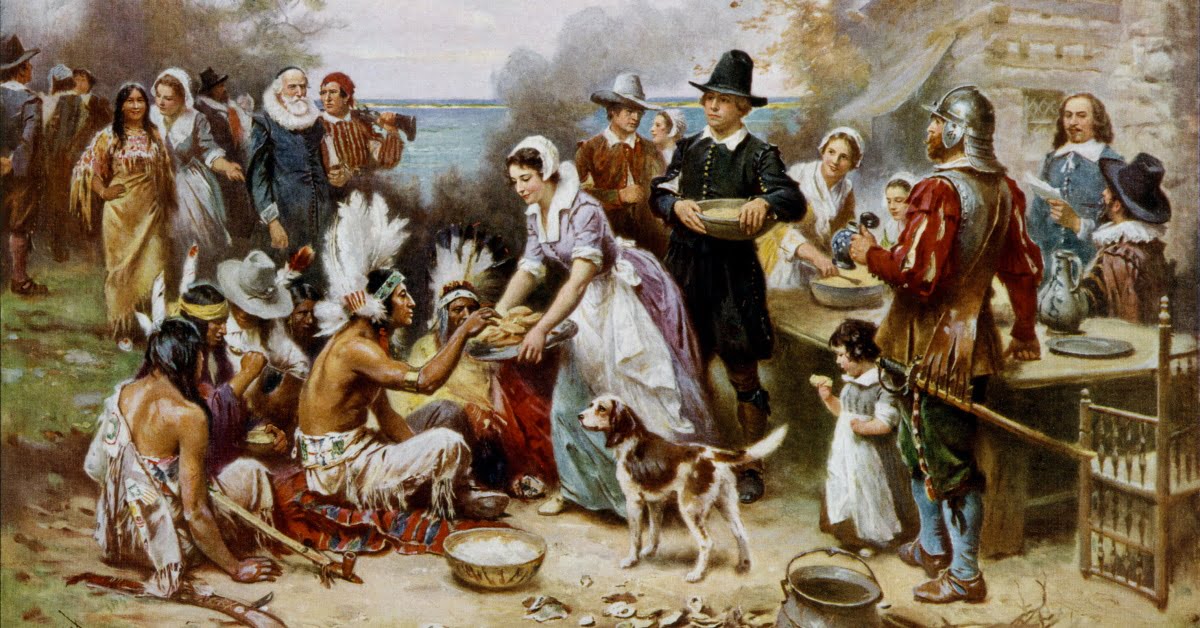A number of sources claim that one of the main American holidays, whose appearance is described in a beautiful legend, was in fact originally timed to coincide with the massacre of the indigenous population of the continent. We checked if this is true.
Traditionally counts, that, having arrived in America at the end of 1620, the settlers had a hard time surviving the winter, but then learned from the local Indians how to grow corn and other crops, distinguish edible plants from poisonous ones, and at the same time adopted many more useful skills. In the fall of 1621, the colonists reaped a good harvest, for which they decided to thank the Lord. The Indians who helped the colonists were invited to the celebration. Since then, the celebration has become regular and today is known as Thanksgiving.
However, recently you can read the following on the Internet: “During one of the next wars, the Indians gathered for their Green Harvest Festival. Now there is the state of Connecticut, the city of Groton. There were 700 Indians - women, children, men and old people. They gathered in one big house. The settlers, having learned about this, tracked them down and launched an attack. The men were killed on the street, everyone else was burned in a large house. Some of the Indians were sold into slavery. In honor of this victory, the governor of the colony declared a Thanksgiving Day. This is how this holiday was celebrated for the first time. <…> Inspired by the victory, the colonists began to destroy one village after another. Some Indians were killed and some were sold. Ships with Indian slaves began to sail from America. Rewards were offered for scalps. After another successful massacre, a second Thanksgiving was declared. This time it happened in Massachusetts, the city of Stamford. This happened many times. The atrocities became increasingly widespread. George Washington noted that the holiday should be celebrated once a year, and not every time after a successful massacre. Abraham Lincoln would later make Thanksgiving an official public holiday. On the day the holiday was approved, Lincoln would order an offensive against the starving Sioux Indians of Minnesota. In fact, Thanksgiving is the day of Indian genocide.”
Such information can be found in Russian-speaking publications on social networks and from English-speaking. In the second case, the story is told by Jay Winter (Nightwolf), an indigenous representative and former presenter radio show "The Truth About American Indians and Other Indigenous Peoples." In the publication of a reputable magazine Time for 2019, it is clarified that this is the first official mention of Thanksgiving - after the massacre of representatives of the Pequot tribe in 1637 in Connecticut. This story is told in more detail in the newspaper Huffington Post. Many publications call for replacing Thanksgiving Day with Indian Genocide Day.
Let's understand what is known for sure about the events of 1637. On the night of May 26, detachments of colonists, together with representatives of two local tribes attacked to a fortified Pequot village near the Mystic River. This campaign became one of the episodes of a long war in which the allies of the said tribe were Dutch settlers, and the ethnic English acted in a coalition with the historical enemies of the Pequots. The attack killed at least 500 local residents, including men, women and children, and burned the village to the ground. The information that has reached us allows us to say that what happened can really be called a massacre or even an attempt at genocide, given how evidence who commanded the British attack, and the fact that the war claimed the lives of more than half of all the Pequots on the planet. Soon one of the first reservations, and by 1910 the size of the ethnic group fell up to 66 people. These days the trend seems to have succeeded straighten.
Now about the reaction to the destruction of the village. John Winthrop, governor of the Massachusetts colony (also at war with the Pequots), wrote in his diary June 15, 1637: “A prayer service was held in all the churches for the victory over the Pequots and other graces.”
A similar event took place in October, on the occasion of new triumphs over the Pequots. Apparently, these prayer services became the basis for the appearance of the version of the origin of Thanksgiving that we are considering. Indeed, in English, a prayer service of thanksgiving is denoted by the same word thanksgiving, which appears in the name of America's favorite holiday. Both in churches and outside of them, such religious dedications (let’s even call them days of thanksgiving) were held regularly in those days. The same John Winthrop often mentions them in his diary - for example, “a day of thanksgiving on all the plantations” for the safe arrival of ships from England in July 1630, seven years before the Mystic River massacre. Another day of thanksgiving was declared in September 1641 "for the success of the Parliament in England."
The Indians who are believed to have helped the first settlers settle in Plymouth Colony (now Massachusetts, east of Connecticut) in 1621 belonged to the tribe Wampanoag. David Silverman, professor at George Washington University and author of This Land Is Their Land: The Wampanoag Indians, Plymouth Colony, and the Troubled History of Thanksgiving, in response to a question about the holiday's connection to the massacre stated: “There is no doubt that a thanksgiving service was held in Connecticut and Massachusetts after these events ... but it is untenable to draw a connection between it and the modern holiday. It was a tradition among the English to celebrate days of thanksgiving to God for his graces. <…> There have been hundreds, if not thousands of Thanksgivings. Some of them involved victories over the Indians, but most did not.”
A similar opinion is shared by Chris Newell, former director of education at the Pequot Museum and Research Center. “As for the English Thanksgivings of the 17th century, they have nothing in common with the holiday we celebrate today,” he says. — This holiday did not exist until the 19th century. The English day of thanksgiving was a day of prayer... a day of fasting, quite distinct from a holiday.”
The holiday is Thanksgiving Day became indeed under President Abraham Lincoln. It is believed that this was an attempt to unify the country against the backdrop of the Civil War. According to Newell, the textbook story of a communal celebration was chosen simply as a beautiful foundation. Moreover, Sarah Josepha Hale, better known as the author of the children's poem, played a key role in promoting this story in newspapers and textbooks "Mary Had a Lamb". David Silverman believes, that a beautiful backstory appeared a little later, towards the end of the 19th century. He adds that the friendly relations between the Wampanoag and the Europeans, which did occur, were the result of cold political calculations of the natives - albeit erroneous, since it did not save their tribe from conquest. The harvest festival took place in 1621, but without the Indians.
And finally, the facts They say that Thanksgiving Day was celebrated even earlier, in 1619, in the Virginia colony. It’s just that, apparently, during the days of the Civil War, it was considered inappropriate to mention the southern state in a positive way, and the role of the pioneer went to Northern Massachusetts.
Thus, although the traditional history of Thanksgiving is not without its myths, the history of the Indian genocide has virtually nothing to do with the current holiday.
Fake
Read on the topic:
1. Was Thanksgiving Originally a Celebration of the Massacre of a Native American Tribe?
If you find a spelling or grammatical error, please let us know by highlighting the error text and clicking Ctrl+Enter.







